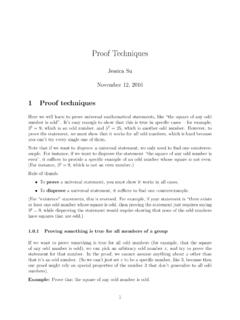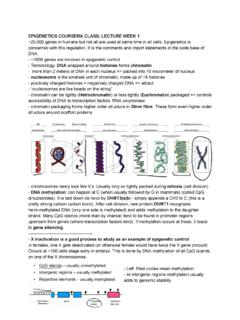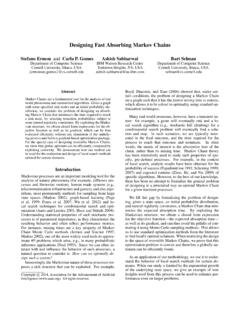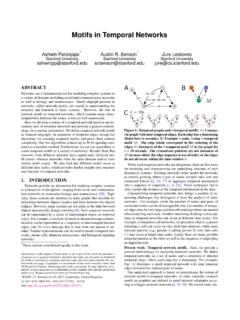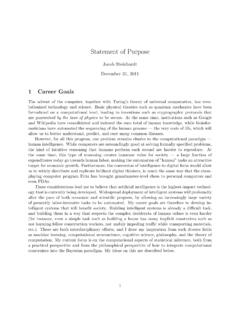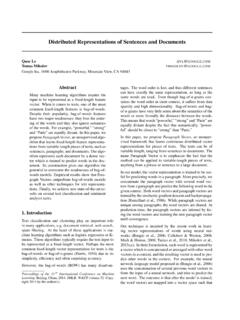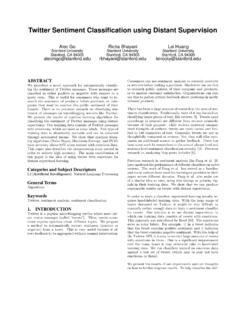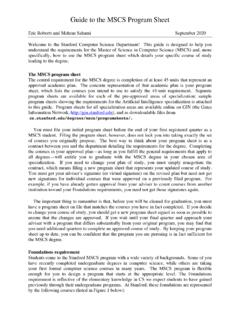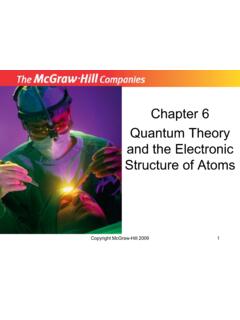Transcription of Quantum Cryptography - Stanford Computer Science
1 Quantum Cryptography J. Aditya, P. Shankar Rao {Dept of CSE, Andhra University}. Email: ABSTRACT because asymmetric encryption is significantly slower than symmetric encryption, a hybrid approach is preferred by many Modern Cryptography algorithms are based over the fundamental institutions to take advantage of the speed of a shared key system process of factoring large integers into their primes, which is said and the security of a public key system for the initial exchange of to be INTRACTABLE . But modern Cryptography is vulnerable the symmetric key. Thus, this approach exploits the speed and to both technological progress of computing power and evolution performance of a symmetric key system while leveraging the in mathematics to quickly reverse one-way functions such as that scalability of a public key infrastructure.
2 However, public key of factoring large integers. So the solution is to introduce Quantum cryptosystems such as RSA and Diffie-Hellman are not based on physics into Cryptography , which lead to evaluation of Quantum concrete mathematical proofs. Rather, these algorithms are Cryptography . Quantum Cryptography is one of the emerging considered to be reasonably secure based on years of public topics in the field of Computer industry. This paper focus on scrutiny over the fundamental process of factoring large integers Quantum Cryptography and how this technology contributes value into their primes, which is said to be intractable . In other words, to a defense-in-depth strategy pertaining to completely secure key by the time the encryption algorithm could be defeated, the distribution.
3 The scope of this paper covers the weaknesses of information being protected would have already lost all of its modern digital cryptosystems, the fundamental concepts of value. Thus, the power of these algorithms is based on the fact Quantum Cryptography , the real-world implementation of this that there is no known mathematical operation for quickly technology along with its limitations, and finally the future factoring very large numbers given today's Computer processing direction in which the Quantum Cryptography is headed towards. power. While current public key cryptosystems may be good We describe results from an apparatus and protocol that is enough to provide a reasonably strong level of confidentially designed to implement the Quantum key distribution by which two today, there is exposure to a handful of risks.
4 For instance, users who share no secret information (without having any private advancements in Computer processing, such as Quantum or public keys known before hand) initially exchange a random computing, may be able to defeat systems such as RSA in a timely Quantum transmission consisting of very faint flashes of polarized fashion and therefore make public key cryptosystems obsolescent light. instantly. As another example, while the DES algorithm, which Keywords has a 56 bit key, was once considered to be secure, it is no longer thought of as such since advancements in technology have made it Quantum Cryptography systems, Large Scale distributed trivial to defeat. The fact that powerful computers may crack DES. computational systems, Cryptosystems, Quantum physics. in a few hours served as a catalyst for the development of the replacement Advanced Encryption Standard.
5 Hence, one area of 1. INTRODUCTION risk is that public key Cryptography may be vulnerable to the Quantum Cryptography recently made headlines when European future technology developments in Computer processing. Union members announced their intention to invest $13 million in Secondly, there is uncertainty whether a theorem may be the research and development of a secure communications system developed in the future or perhaps already available that can based on this technology. The system, known as SECOQC factor large numbers into their primes in a timely manner. At (Secure Communication based on Quantum Cryptography ), will present, there is no existing proof stating that it is impossible to serve as a strategic defense against the Echelon intelligence develop such a factoring theorem.
6 As a result, public key systems gathering system used by the United States, Australia, Britain, are thus vulnerable to the uncertainty regarding the future creation Canada and New Zealand. In addition, a handful of Quantum of such a theorem, which would have a significant affect on the information processing companies, including MagiQ algorithm being mathematical intractable. This uncertainty Technologies and ID Quantique, are implementing Quantum provides potential risk to areas of national security and intellectual Cryptography solutions to meet the needs of businesses, property which require perfect security. In sum, modern governments, and other institutions where preventing the Cryptography is vulnerable to both technological progress of unauthorized disclosure of information has become a critical computing power and evolution in mathematics to quickly reverse success factor in maintaining a competitive advantage over one way functions such as that of factoring large integers.
7 If a adversaries. While the modern cryptosystems are said to be very factoring theorem were publicized or computing became powerful effective in other words they are said to be INTRACTABLE enough to defeat public Cryptography , then business, then why a lot of money is been spent to develop a new governments, militaries and other affected institutions would have cryptosystem Quantum Cryptography ? to spend significant resources to research the risk of damage and potentially deploy a new and costly Cryptography system quickly. 2. Limitations of Modern Cryptosystems Since public key Cryptography involves complex calculations that 3. Quantum Cryptography in Theory are relatively slow, they are employed to exchange keys rather Rather than depending on the complexity of factoring large than for the encryption of voluminous amounts of data.
8 For numbers, Quantum Cryptography is based on the fundamental and example, widely deployed solutions, such as the RSA and the unchanging principles of Quantum mechanics . In fact, Quantum Diffie-Hellman key negotiation schemes, are typically used to Cryptography rests on two pillars of 20th century Quantum distribute symmetric keys among remote parties. However, mechanics the Heisenberg Uncertainty principle and the principle of photon polarization. According the Heisenberg polarization. These photons are used to form the basis of a one- Uncertainty principle, it is not possible to measure the Quantum time pad for sending encrypted information. It is important to state of any system without disturbing that system. Thus, the point out that neither Alice nor Bob are able to determine what the polarization of a photon or light particle can only be known at the key will be in advance because the key is the product of both their point when it is measured.
9 This principle plays a critical role in random choices. Thus, Quantum Cryptography enables the thwarting the attempts of eavesdroppers in a cryptosystem based distribution of a one-time key exchanged securely. on Quantum Cryptography . Secondly, the photon polarization principle describes how light photons can be oriented or polarized in specific directions. Moreover, a photon filter with the correct polarization can only detect a polarized photon or else the photon will be destroyed. It is this one-way-ness of photons along with the Heisenberg Uncertainty principle that make Quantum Cryptography an attractive option for ensuring the privacy of data and defeating eavesdroppers. Charles H. Bennet and Gilles Brassard developed the concept of Quantum Cryptography in 1984 as part of a study between physics and information.
10 Bennet and Brassad stated that an encryption key could be created depending on the amount of photons reaching a recipient and how they were received. Their belief corresponds to the fact that light can behave with the characteristics of particles in addition to light waves. These photons can be polarized at various orientations, and these orientations can be used to represent bits encompassing ones and zeros. These bits can be Figure 2. Quantum Key Distribution Example used as a reliable method of forming onetime pads and support systems like PKI by delivering keys in a secure fashion. The representation of bits through polarized photons is the foundation of Quantum Cryptography that serves as the underlying principle Now let us suppose that a malicious attacker attempts to infiltrate of Quantum key distribution.
